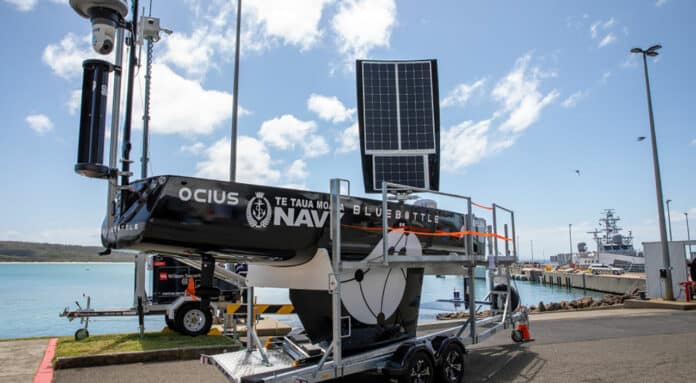The Royal New Zealand Navy (RNZN) is set to receive the delivery of a 6.8-metre renewable-powered Uncrewed Surface Vessel (USV) to trial on a short-term lease.
Uncrewed Surface Vessels (USVs) are versatile platforms that offer the potential to undertake a wide variety of roles for the New Zealand Government. These could include fishery protection, border protection, and meteorological data collection.
The vessel will be transported from Sydney to Auckland by HMNZS Aotearoa. Once it becomes operational, it will be able to perform maritime tasks at sea without fuel or personnel on its planned seven-month-long trial.
Called “Bluebottle,” the USV is designed and manufactured by Sydney-based Ocius Technology. The company has already sold several USVs to the Australian Defence Force and collaborated with the Australian Border Force, energy, and scientific agencies.
Bluebottle is powered by solar, wind, or wave energy and uses a retractable rigid sail to provide wind propulsion. Photo-electric cells on the sail can drive its motor. In case of low sunlight and wind, the vessel has a unique flipper and rudder device that enables it to steer and propel itself. It can travel at a maximum speed of five knots and operate at sea for an indefinite period, even in rough conditions with wave heights of six to nine meters.
The vessel is equipped with various sensors such as radar, electro-optic, and infrared cameras that ensure safe and efficient navigation and help identify other vessels. The USV will be constantly monitored and operated from a control room located at Devonport Naval Base. Communication with the control room is through mobile phone signal while close to shore or via high- and low-bandary satellites when further offshore. The vessel will be constantly surveilled to ensure its safe and efficient operation.
“Our EEZ is the fifth largest in the world at more than four million square kilometers. Coupled with the 30 million square kilometer search and rescue area that New Zealand has responsibility for, that is a lot of ocean to cover,” RNZN’s Maritime Component Commander, Commodore Garin Golding, said in a statement. “The evidence we’ve seen from our partner militaries overseas is that uncrewed drone aircraft and vessels can provide real value in fulfilling some of these search and surveillance tasks.”
The RNZN’s Autonomous Systems Staff Officer, Commander Andy Bryant, is also looking forward to the USV demonstrating its potential.
“The Bluebottle has already undertaken a range of activities in support of the Australian Government for long periods of time without the need for refueling, recharging, or crew respite,” he said.
“I’m confident we will see similar benefits from the time we have with the vessel, particularly a better understanding of how to operate and sustain uncrewed vessels, and this will provide a great opportunity to share experiences on the new system with the Royal Australian Navy,” Bryant added.
The USV seems to be quite versatile in terms of transportation. It can be easily transported by trailer to various locations in New Zealand and launched and recovered from a boat ramp. Additionally, it can be craned on and off a Navy ship, making it a great option for operations while deployed overseas.
